OUTCOME 5: COOPERATION
Effective Dialogue and Cooperation between the Member Countries and Strategic Engagement of Regional Partners and Stakeholders on Transboundary Water Management
INDICATORS • Evidence of strong engagement with China and Myanmar • Evidence of ASEAN- and Great Mekong Subregion Mekong-related strategies, forums and meetings reflect MRC basin-wide perspectives • Evidence that the opinions/perspectives of academic/research institutions, civil society, and the private sector are taken into consideration by the MRC Secretariat and Member Countries
The MRC has excelled in promoting effective dialogue and cooperation between MCs, with its Dialogue Partners in the Upper Mekong Basin, in particular China, with its regional and international partners, and with the broader stakeholders. The sustained outreach and dialogue with China have led to the achievement of several important milestones including: two joint studies; the renewal of China’s agreement to share Lancang hydrological data during the flood season, which began in 2002; the new historic agreement reached in 2020 to share dry season data; the inclusion of the MRC Secretariat in the meetings of the LMC Joint Working Group on Water Resources; and the signing of the MOU between the LMC Water Centre and the MRC Secretariat. The cooperation between MRC and China and Myanmar reached a new high level during the 3rd MRC Summit, during which ministerial and senior representatives from China and Myanmar made commitments to work with the MRC, including through the LMC. The MRC’s efforts to pursue broader collaboration have also resulted in a growing list of strategic and technical partners, further contributing to the positive global and regional recognition of the MRC. By the end of 2020, the MRC accumulated over 30 MOUs with various regional and international partners. The MRC’s partners include regional organizations (ASEAN, ADB, ADPC, AWC, LMC Water Centre, and SEAFDEC); United Nations agencies (UNEP, UNOPS, UNESCAP, UNDPPA, UNECE, and FAO); international/national river basin organizations (MiRC, MDBA, ICPR, ICPDR, CNR); and think tanks, research institutes, academia, and others (ASU, MSU, VNSC, AIT, GWP, IOWater, IUCN, WWF, SEI, IWMI, MI, JICA, KDI, and K-Water). The MRC’s central leadership in the region was evident when, for the first time, it brought together senior representatives from the Mekong countries and seven major Mekong-related regional cooperation frameworks to discuss and explore opportunities for improved coordination and collaboration in water and related areas. This was preceded by another achievement – the conclusion of a new cooperation framework agreement between the MRC and ASEAN, which is comprehensive in scope because the agreement is between the two organizations. The MRC has also made strides in enhancing the involvement of the broader stakeholders, which include international NGOs, regional and national river networks and coalitions, national CSOs, the private sector and the general public. Through several mechanisms that include 10 RSFs, specific NGO dialogues, forums for private sector engagement, and social media campaigns, the MRC has benefited from stakeholders’ more meaningful participation from which their comments, opinions, and suggestions have been incorporated in various MRC products including the BDS, PNPCA Joint Statements, Technical Review Report, the PDG, and the SHDS, among many others. Finally, throughout 2016–2020, the MRC has worked to preserve the trust and support of its Development Partners. The Development Partners provided total financial support of approximately USD 43.8 million to the MRC for the 2016–2020 strategic planning cycle.
International cooperation at the highest level
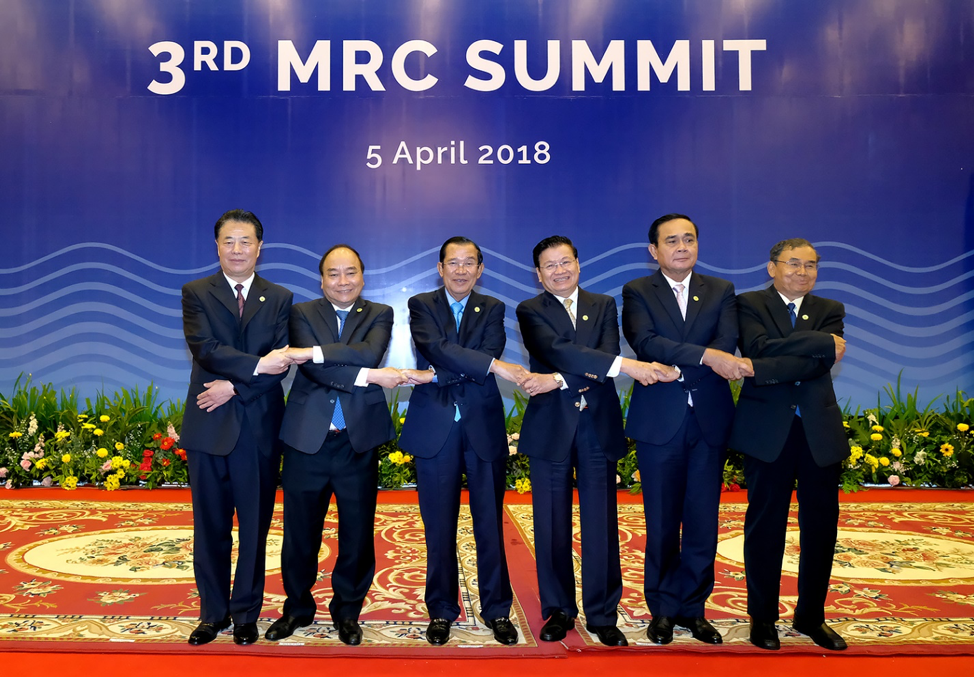
Heads of Governments of the MRC Member Countries (Prime Ministers Nguyen Xuan Phuc of Viet Nam, Hun Sen of Cambodia, Thongloun Sisoulith of Lao PDR, and Prayut Chan-o-cha of Thailand) shake hands in consolidating cooperation with ministers from China and Myanmar during the 3rd MRC Summit, April 2018.
For the third time in its history, Mekong cooperation under the MRC was featured at the highest level, that is, the MRC Summit, which is arguably the most high-profile international event, not only among MRC MCs, but also partners and stakeholders. In April 2018, the MRC marked its 23rd anniversary through the convening of the 3rd MRC Summit led by the Prime Ministers of the Governments of Cambodia, Lao PDR, Thailand and Viet Nam. The 3rd Summit had the motto, ‘One Mekong, One Spirit’. The main outcome of the 3rd MRC Summit was the Siem Reap Declaration, issued by consensus of the four Mekong Prime Ministers, which considered the vital importance of development and management of the water and related resources of the Mekong River Basin, and reaffirmed the highest level of political commitment to the more effective implementation of the 1995 Mekong Agreement, the MRC’s primary importance as a regional cooperation framework, and its unique role as a knowledge hub. The MRC Summit’s International Conference, held prior to the Summit, served two purposes, offering a space for exchanges on transboundary water management between experts and stakeholders from the Mekong and other regions, and serving as a mechanism to contribute to the Summit by sharing key messages. The key messages included the need for the use of best practices and new ideas for the sustainable management and development of the Mekong River Basin. The International Conference was held under the overall theme, “Enhancing Joint Efforts and Partnerships towards Achievement of the Sustainable Development Goals in the Mekong River Basin”, which spelled out who should be involved to achieve this goal at national and regional levels.
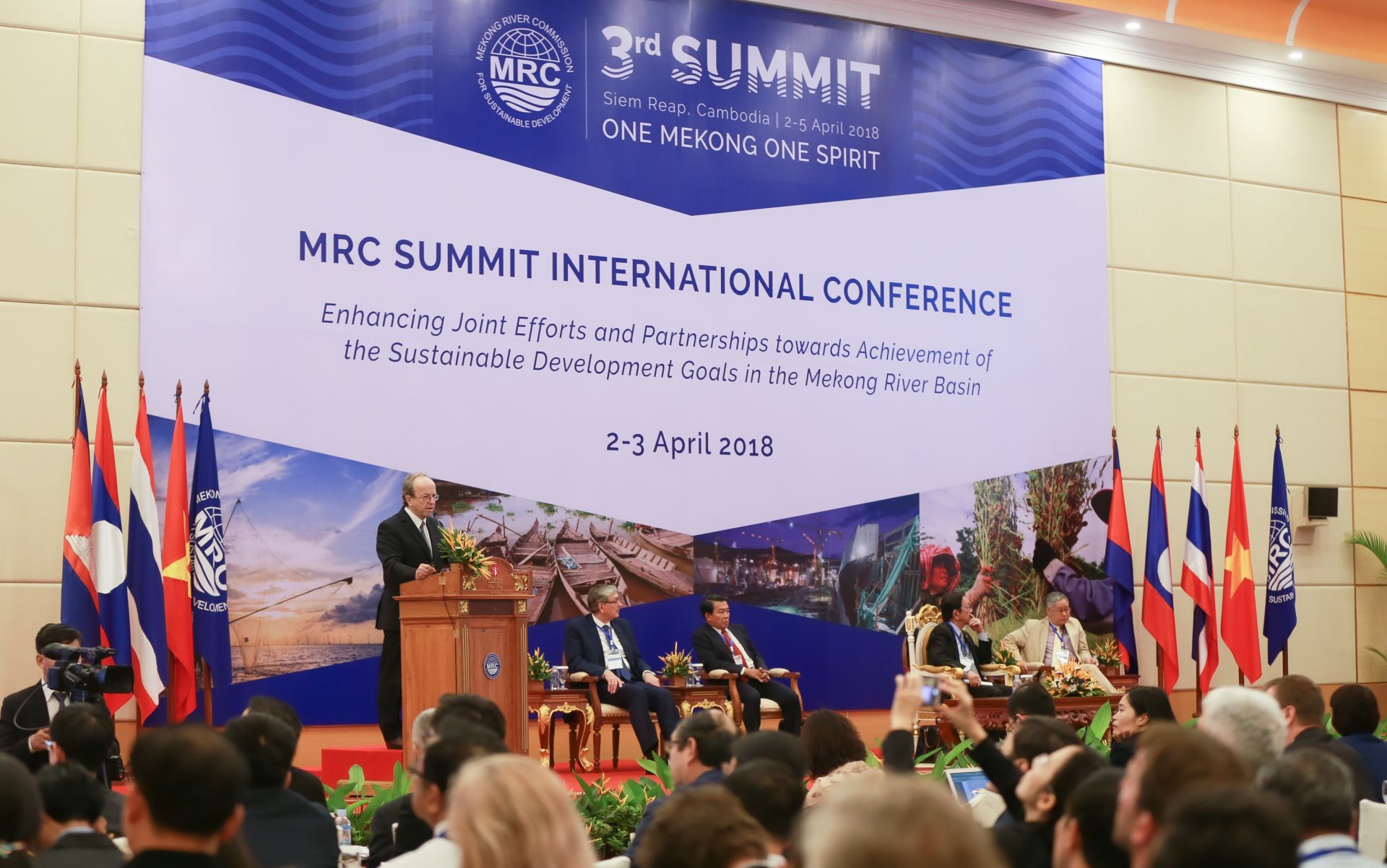
The MRC International Conference draws 400 participants from around the world, including world-renowned water leaders such as David Grey of Oxford University and Danilo Turk, Chair of the United Nations High-Level Panel on Water and Peace and former President of Slovenia.

During the MRC International Conference, H.E. Mr Lim Kean Hor, Minister of Water Resources and Meteorology and MRC Council Member for Cambodia, and delegates observe essays that capture “Voices of the Mekong” – different perspectives from Mekong citizens on their challenges and hopes for better futures.
On cooperation with China and Myanmar The MRC has achieved significant progress in advancing cooperation with China as well as the LMC, which was established by China, Myanmar and the four LMB countries in 2016. The cooperation between the MRC and China, which dates back to 1996, has significantly increased during the strategic planning cycle 2016–2020 and has occurred through several mechanisms, including annual dialogue meetings, data and information sharing for the flood season (uninterrupted since 2002), one joint symposium, two joint studies, and numerous exchange visits on water resources development, environmental protection, flood and drought, and hydropower development. Junior Riparian Professionals from China and Myanmar worked and received training in the MRC Secretariat, and subsequently served as important links between the Dialogue Partners and the MRC. The cooperation between the MRC and China and Myanmar reached a new, high level during the 3rd MRC Summit in which ministerial and senior representatives from China and Myanmar made commitments to Mekong leaders to work with the MRC, including through the LMC. “China attaches great importance to the cooperative relations with the MRC, and has carried out diversified, fruitful, and practical cooperation with the MRC and its Member Countries. China welcomes the MRC and its Secretariat to play a constructive role in Lancang-Mekong water resources cooperation. We also encourage Chinese companies to participate in water development in Mekong countries, following the principle of sustainable development and win-win cooperation.” – H.E. Mr E. Jinping, Minister of Water Resources, People’s Republic of China, April 2018
This increasing cooperation with China has led to the achievement of major milestones, such as: • the release of the Emergency Water Supplement by China during the 2016 drought and the subsequent collaboration in producing a first-ever Joint Observation Report; • the renewal of the data sharing agreement on the flood season between China and the MRC in 2018, which was expanded in 2020 to include the dry season (thus covering hydrological data year-round); • the signing of the MOU between the MRC Secretariat and the LMC Water Centre; • the granting of observer status to the MRC Secretariat to participate in the LMC Joint Working Group on Water Resources meetings.

Dr An Pich Hatda, second riparian CEO of the MRC Secretariat, and senior representatives from China’s Ministry of Water Resources present the historic agreement on year-round data sharing between China and the MRC (October 2020).
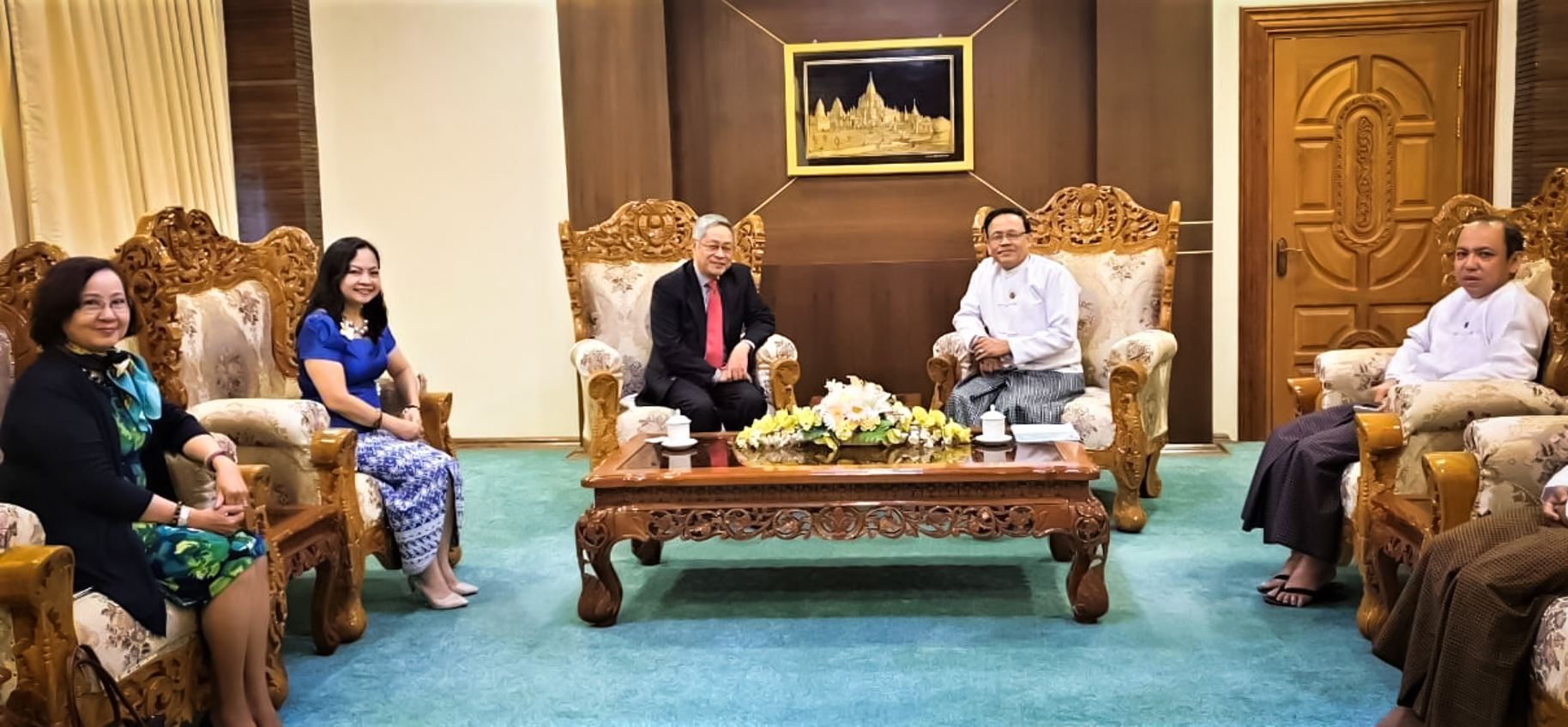
Dr Pham Tuan Phan, CEO of the MRC Secretariat, meet with Myanmar’s Minister of International Cooperation H.E. U Kyaw Tin, and Minister of Natural Resources and Environmental Conservation H.E. U Ohn Win, in Napitaw, to discuss strengthening cooperation between the MRC and Myanmar (9 December 2018).
Notable examples of this advanced cooperation include the following:
• joint research on the hydrological impacts of the Lancang dam cascade on extreme floods and droughts, with China and IWMI, which began in 2017 and was completed in 2019; • jointly organized the 3rd Technical Symposium on ‘Capacity Building and Experience Sharing on Sediment Control and Management for River Dams’, with China’s Ecosystem Study Commission for International Rivers (ESCIR), on 16–17 October 2017 in Nanjing, China; • first-ever visit to China by the MRC Council of Water and Environment Ministers from the four MCs as a group in December 2019, and attendance at the first Ministerial Meeting of the LMC Water; • provision of feedback and information to the preparation of the SOBR 2018 by China and Myanmar; • participation and exchanges in various dialogue meetings in China including: the Second Global Centre for Mekong Studies Think Tank Forum on 21–22 March 2019 in Vientiane; the Lancang-Mekong Roundtable Dialogue on the Outlook for Strategic Environmental Assessment (SEA) by Lancang-Mekong Environmental Cooperation Centre in Kunming on 20–22 March 2019; the China-ASEAN Countries Workshop on Flood Control, Drought Relief and Integrated Water Resources Management by the LMC Water Centre on 4–8 August 2019 in Yunnan province; and the Workshop on Integrated Planning and Management of River Basin by the LMC Water Centre in Guanzhou in November 2019; • participation and exchanges in Myanmar: the MRC Secretariat’s mission to Myanmar in June 2017; Ayeyarwady State of Basin Assessment Inception Workshop, June 2017 in Yangon; CEO meetings with high-level officials in Myanmar in 2018; and the Water, Land and Ecosystems (WLE) Greater Mekong Forum in Yangon in December 2018.
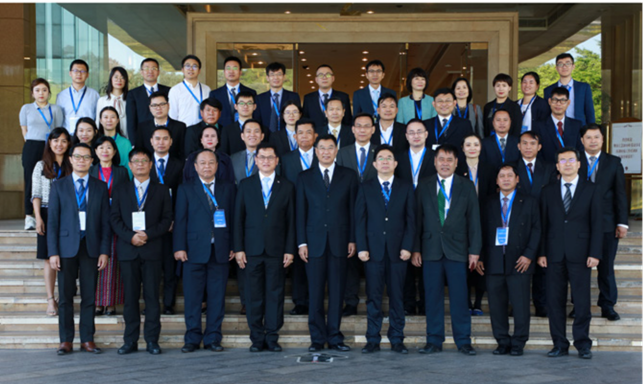
The MRC Secretariat, represented by Dr Anoulak Kittikhoun, Chief Strategy and Partnership Officer (left, front row), participates for the first time in the 3rd Special Meeting of the Lancang Mekong Cooperation Joint Working Group on Water Resources Cooperation in Guangdong, China (29 and 30 October 2019)
On cooperation with regional and international partners One aspect of the MRC’s unique identity and history is its openness to cooperate with a broad spectrum of partners from all over the world. The sheer number and quality of the MRC’s partners reflect both the organization’s efforts and reputation for partnership excellence, and the importance of the Mekong in the international arena. During the period, MRC’s growing list of strategic and technical partners includes regional organizations (ASEAN, ADB, ADPC, AWC, LMC Water Centre, and SEAFDEC); United Nations agencies (UNEP, UNOPS, UNESCAP, UNDPPA, UNECE, and FAO); international/national river basin organizations (MiRC, MDBA, ICPR, ICPDR, CNR); and think tanks, research institutes, academia, and others (ASU, MSU, VNSC, AIT, GWP, IOWater, IUCN, WWF, SEI, IWMI, MI, JICA, KDI, and K-Water as well as Morocco). By the end of 2020, the MRC had accumulated over 30 MOUs with various regional and international partners. In 2018, following two years of preparation, the cooperation between MRC and ASEAN, the premier regional cooperation body in Asia, was elevated to a new Cooperation Framework following two years of review, preparation, and negotiation. Building on the previous secretariat-to-secretariat MOU, the new agreement aims to foster cooperation between the two organizations and their member states, four of which are the same, in the areas of strategic and basin planning, environmental management, and disaster risks management, among others. ASEAN provided inputs to the preparation of the BDS and the emergency procedure of the PWQ. In 2020, it was agreed that the first ASEAN-MRC Water Security Dialogue would be held in 2021.
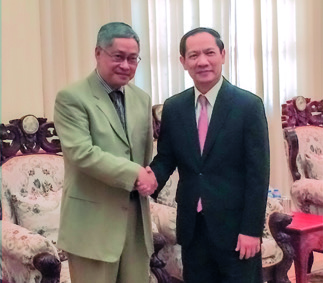
Dr Pham Tuan Phan, first riparin CEO of the MRC Secretariat, meets with H.E. Mr Alounkeo Kittikhoun, Minister to the Prime Minister’s Office and ASEAN Senior Officials Meeting (SOM) Leader of Lao PDR, in Lao PDR’s capacity as ASEAN Chair in 2016. The meeting lays the foundation to renewing cooperation between the MRC and ASEAN.
Through the MOU, SEAFDEC financially contributed to and actively participated in: (i) the development of the BFMS and its Project Based Action Plan 2021–2025; and (ii) the implementation of the BFMS/PBAP 2021–2025, including the recent development of two Technical Guidance documents: Transboundary Fisheries Management, and Protection and Restoration of Key Fish Habitats with Regional Importance in the LMB. During the 2016–2020 period, areas of cooperation with ADPC focused on improving riverine forecasting for the LMB, reservoir monitoring for flood and drought management, using the rainstorm tracker tool to enhance the Flash Flood Guidance System, and enhancing drought monitoring, forecasting, and management. The engagement of the United Nations organizations in the Mekong, especially the United Nations Economic and Social commission for Asia and the Pacific (UNESCAP) and UNDP, has a deep history dating back to the previous Mekong Committee from the late 1950s to the 1980s. While the United Nations’ involvement decreased since the establishment of the MRC in 1995, cooperation with the United Nations renewed during the past five years with new MOUs signed with UNESCAP, UNOPS and UNEP. UNEP and the MRC worked together on addressing plastic pollution in the Mekong. UNDPPA supported the MRC with the deployment of experts on conflict management to advise and participate in the first Mekong Regional Water Diplomacy Workshop in 2016 and the International Conference in 2018. UNECE engaged the MRC Secretariat and MC officials in a number of expert and working groups and meetings on transboundary water management, nexus assessment, financing of river basin organizations, climate change adaptation, and water allocation, and featured MRC works and results in United Nations handbooks and reports on these matters. New and renewed partnerships and collaboration were reached with well-known river basin organizations such as the MiRC in the United States of America, the MDBA in Australia, and the CNR in France. With the MiRC, which is technically backstopped by the US Army Corps of Engineers (USACE), there were two highlights – the “High Water Inspection”, in which the MRC Council members and the MRC Secretariat CEO participated in April 2017, and the “Low Water Inspection” and associated public hearings, in which the MRC Joint Committee, the MRC Secretariat CEO, and senior staff participated in August 2019. During the public hearings, the MRC leaders learned first-hand how MiRC Commissioners engaged directly with the public to hear concerns, which helped formulate solutions. Inspired by the MiRC’s good example, during the MRC’s own stakeholder forum later that year, the MRC Joint Committee members and the CEO met and engaged directly with Mekong stakeholders, facilitated by the MRC Secretariat Chief Strategy and Partnership Officer.
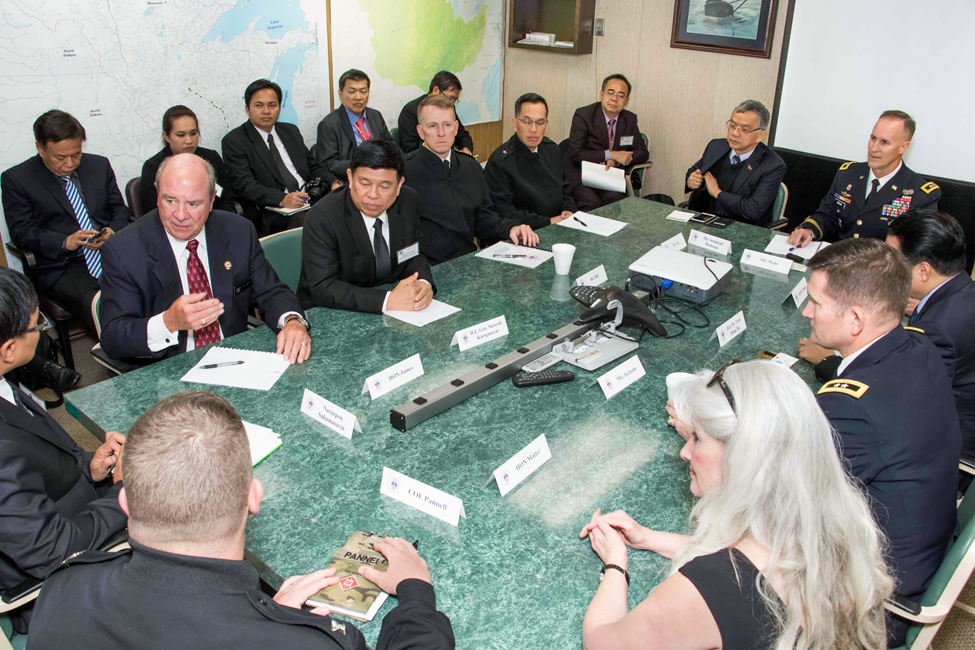
MRC Council members, Minister Sommad Pholsena of Lao PDR, Minister General Surasak Karnjanara of Thailand, and Minister Tran Hong Ha of Viet Nam, exchanged views with the Mississippi River Commission led by its President, Maj. General Michael C. Wehr, of the United States (April 2017).
The renewal of the MOU between the MDBA and the MRC in 2019 to collaborate on many areas, including Mekong Basin-wide planning, environmental monitoring, flood and drought management, climate change adaptation, and stakeholder engagement was yet another accomplishment. It was conducted during a successful, high-level exchange visit, “Mekong-Australia Renewable Energy Dialogue” in June 2019, in which senior leaders and decision-makers from the MRC MCs discussed with Australian policymakers and experts how to deal with enormous challenges both in Australia and the Mekong.
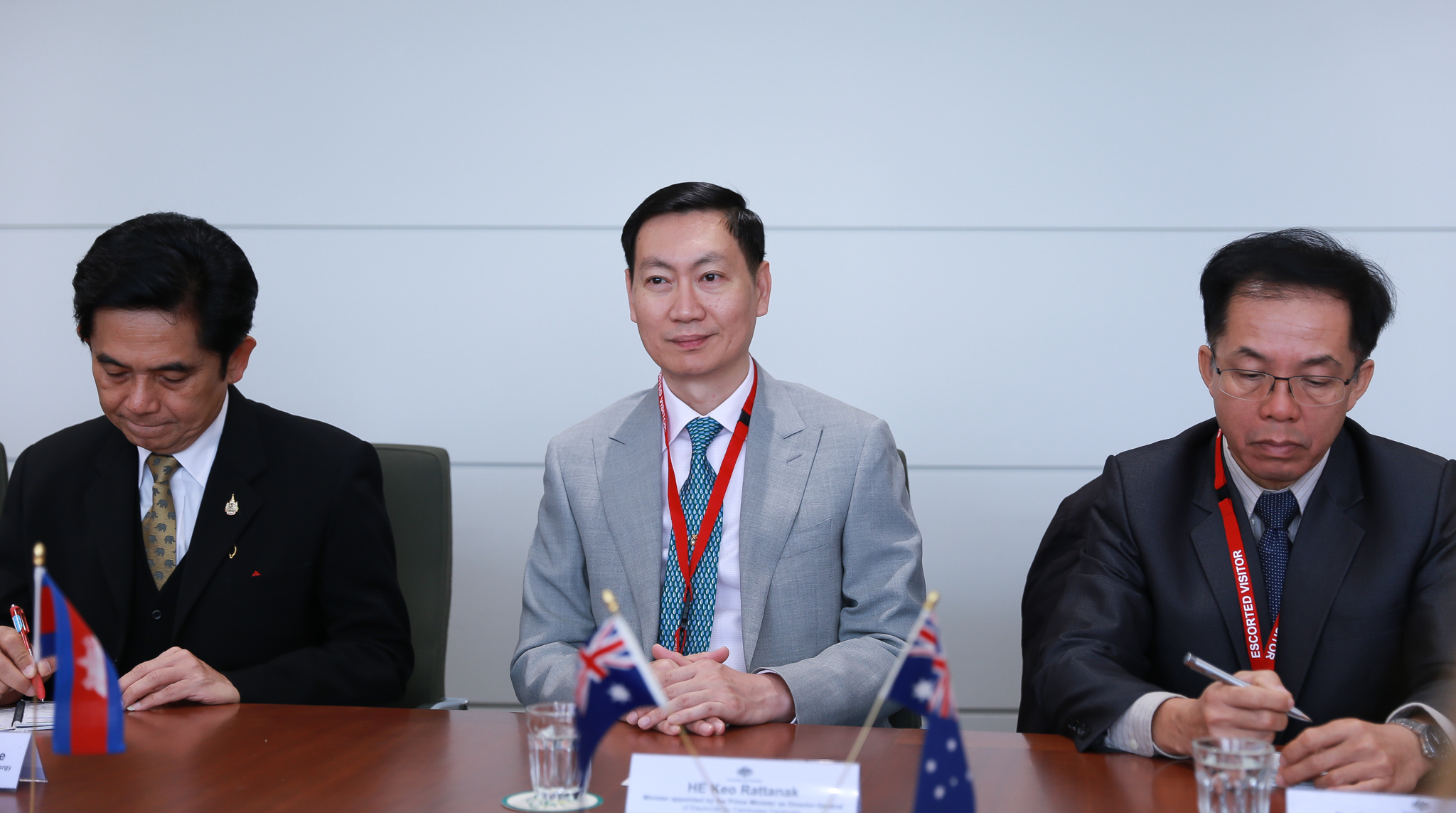
H.E. Keo Rattanak (middle), Minister's Office and the Managing Director for Electricite du Cambodge, and Dr Daovong Phonekeo (right), then Permanent Secretary and now Minister of Energy and Mines of Lao PDR join a meeting with Australia's Department of Foreign Affairs and Trade senior officials during the Mekong-MRC visit to Australia (June 2019).
H.E. Keo Rattanak said the discussion on renewable energy such as solar and wind power was relevant to Cambodia because the country wanted to develop cleaner energy that is healthy to the environment and affordable to the people. Dr Daovong Phonekeo also noted that the new information and knowledge on how to increase the share of renewable energy in Australia is inspiring and particularly important to Lao PDR.
Similarly, in its efforts to better understand various approaches in managing and operating multi-purpose dams that could be adapted and applied regionally, an increasing important issue for the Mekong, MCs and Secretariat senior staffers conducted an exchange visit in June 2018 to the Rhone river basin and CNR, the French public company responsible for the development and management of the Rhone. The participants highly appreciated the approach that CNR took to manage and operate the dams it built from a comprehensive and whole-of-river basin perspective, which must meet three equally important objectives: power generation, navigation, and irrigation. Hence, the two latter objectives “have to be met even if it means generating less power”. The Mekong could definitely learn from this as it further develops its projects.
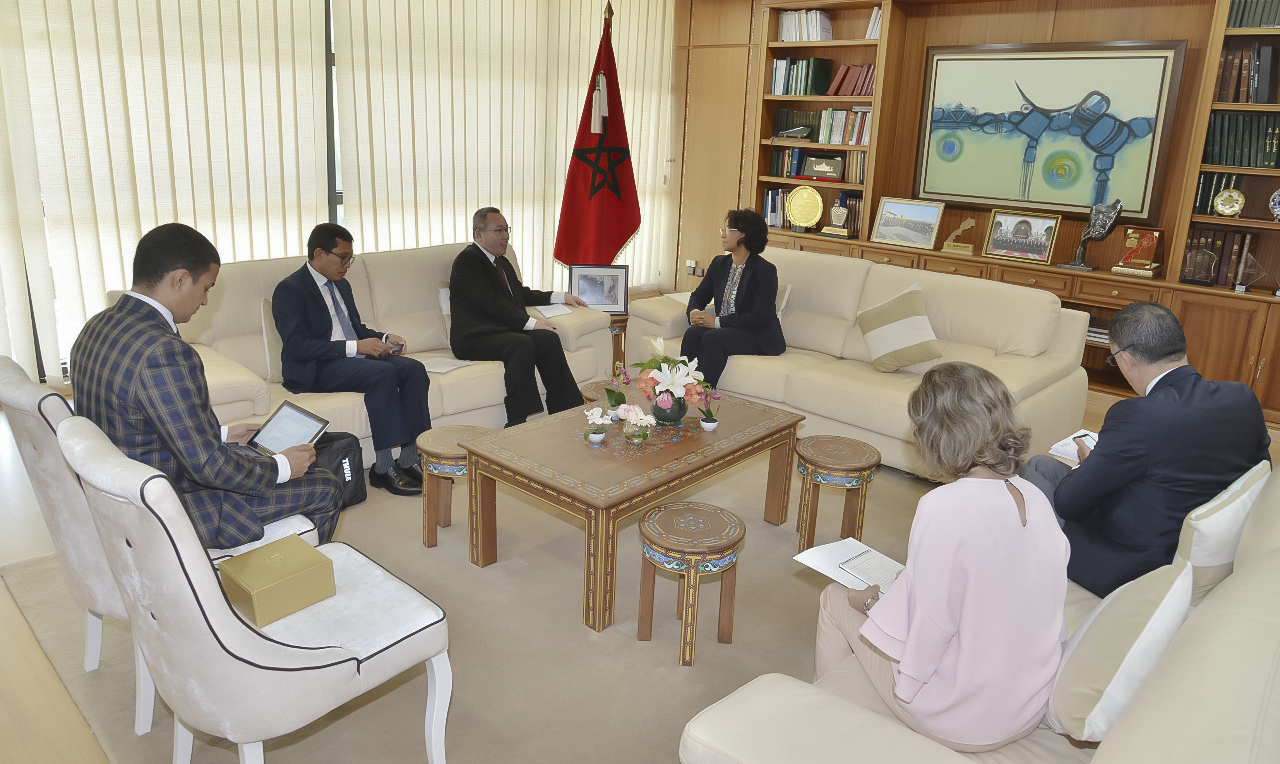
Dr An Pich Hatda, MRC Secretariat CEO, meets with Her Excellency Mounia Boucetta, Secretary of State to the Moroccan Ministry of Foreign Affairs and International Cooperation, in Morocco's capital City Rabat, to discuss how the MRC and Morocco should concretize their cooperation (4 October 2019)
The partnership with Morocco is also notable since Morocco is the first African and Arab country to become a partner of the MRC. The MRC and Morocco’s MOU, which was signed in June 2017, stipulates nine potential areas of collaboration, including areas of particular Moroccan expertise such as solar energy, drought management, human development, and agriculture and food security. Several exchange visits have occurred since then, including Morocco’s Secretary of State of Foreign Affairs attending the 2018 MRC Summit, and the MRC Secretariat CEO paying an official visit to Morocco in 2019.
Finally, recognizing the benefit of developing and strengthening its relationships with the various Mekong-related cooperation frameworks, the MRC brought together, for the first time, senior representatives from the Mekong countries and seven major Mekong-related regional cooperation frameworks during its 2nd Expert Group on Strategy and Partnership meeting on 15 August 2019 in Phnom Penh. This aimed to promote joint efforts in the water sector through a more coherent and effective coordination. The organizations and cooperation frameworks represented included the ASEAN Secretariat and Asian Development Bank, which supports the Greater Mekong Subregion Economic Cooperation Programme, Ayeyawady-Chao Phraya-Mekong Economic Cooperation Strategy (backstopped by Thailand), Mekong-Japan Cooperation, Mekong-Korea Cooperation, Lower Mekong Initiative (backstopped by the United States of America), and the LMC on Water (backstopped by the LMC Water Center). The participating organizations presented the status of their ongoing and future projects and programmes in the water, energy, disaster and environment-related fields in supporting the Mekong countries, and discussed and explored opportunities for collaboration and the reduction of duplication of work.
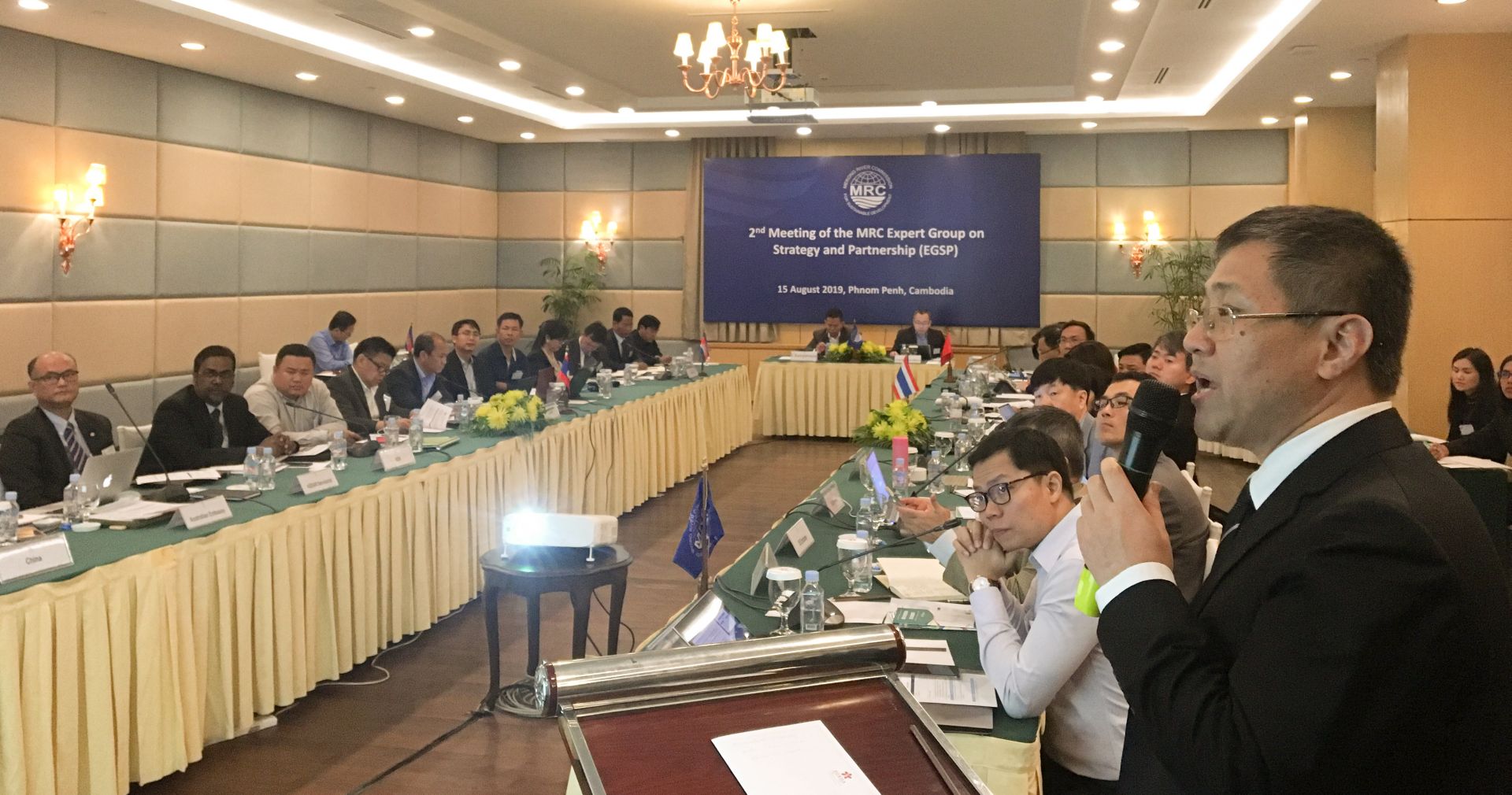
Mr Dong Yanfei, Deputy Secretary General of the LMC Water Center, speaks at the 2nd MRC Expert Group on Strategy and Partnership meeting about LMC’s ongoing and future projects and programmes in the Mekong region, and cooperation with the MRC (August 2019).
On maintaining strong support of Development Partners The MRC’s ability to maintain its strong relationship with Development Partners has enhanced the organization’s capacity not only in terms of its financial wherewithal, but also organizational strengthening in financial management and internal processes and operations. For the MRC SP 2016–2020 period, the MRC received funding support from Australia, Belgium, the European Union, France, Germany, Japan, Luxemburg, Netherlands, Sweden, Switzerland, the United States of America, and the World Bank. Overall, the total financial support that the Development Partners provided to MRC for the strategic planning cycle was approximately USD 43.8 million.
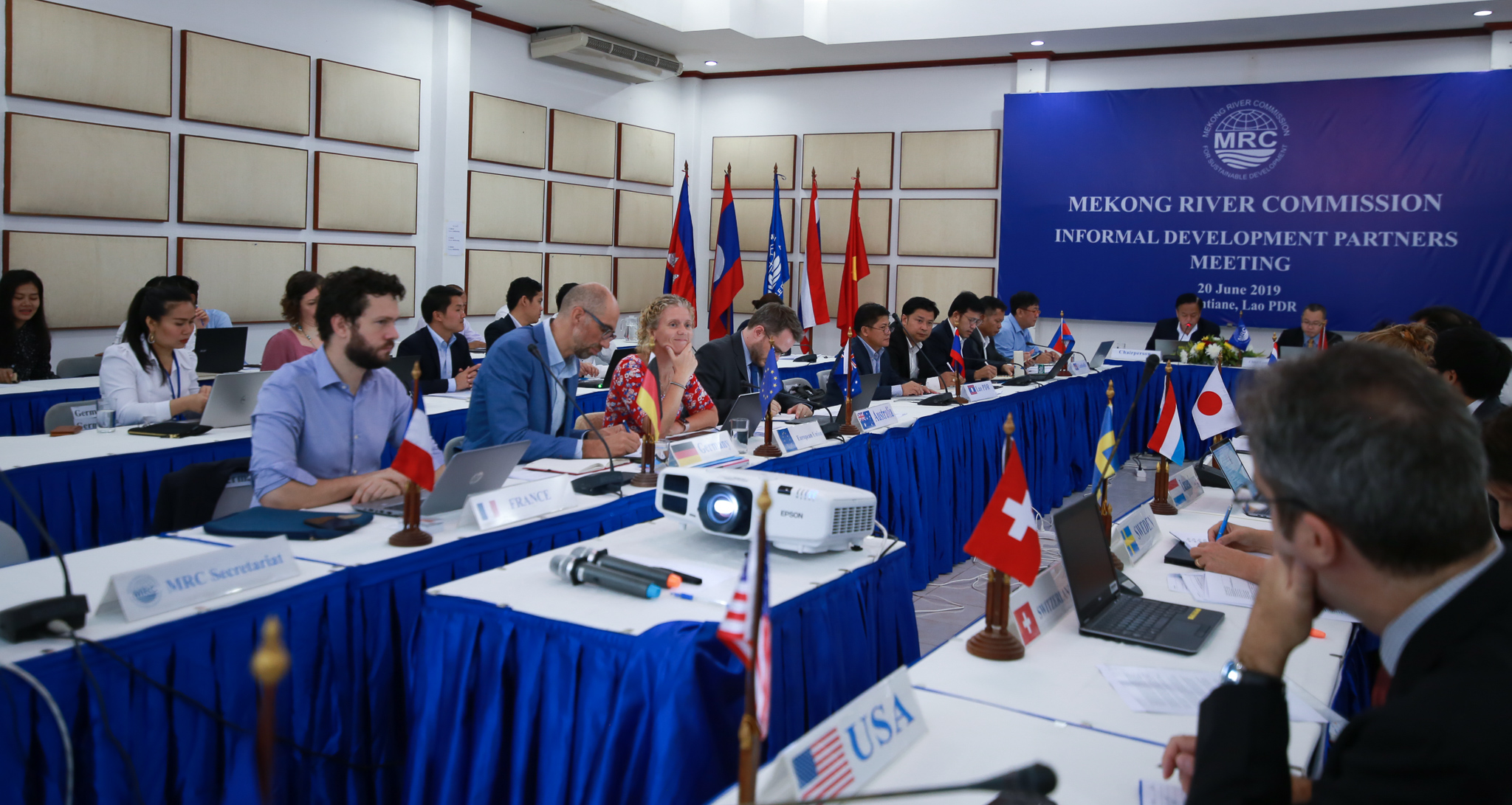
MRC Informal Development Partners meeting in June 2019, where the MRC Joint Committee and Secretariat held a dialogue with Development Partners on the MRC's work and ways to enhance cooperation.
On engagement of broader stakeholders
The MRC has made important strides in enhancing the participation of the broader stakeholders, which include international NGOs, regional and national river networks, coalitions and civil society organizations (e.g. Save the Mekong, Viet Nam River Network, NGO Forum in Cambodia, Rivers Coalition in Cambodia, Living River Association, Green Community Alliance), academia and the private sector (especially consultants, developers and operators of hydropower, irrigation, and navigation facilities). The MRC has hosted numerous events as part of its stakeholder outreach, including its institutionalized and standing RSF. Starting with the first RSF in February 2017, the MRC has hosted a total of 10 RSFs on important topics of public interest that include the PNPCA PCs of the mainstream hydropower dams, the SOBR, the Council Study, hydropower strategy, watershed management, and the BDS, among others. Due to the COVID-19 pandemic, the MRC conducted the 10th RSF in an innovative manner, a mixture of physical and virtual interactions, which drew a large and engaged audience. The RSF proved to be a highly effective mechanism to communicate key MRC outputs under each of the seven outcomes of the MRC SP 2016–2020 with various stakeholders.
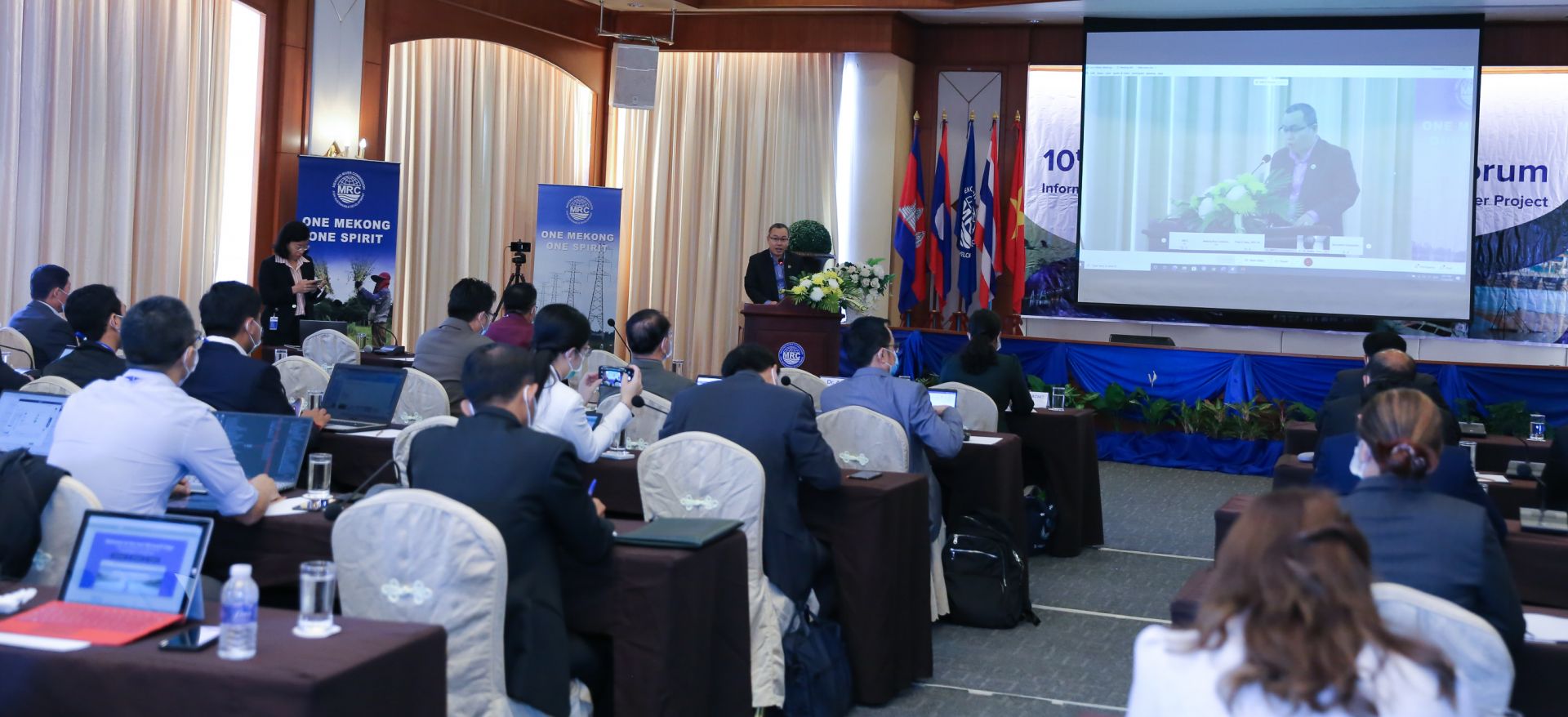
The 10th Regional Stakeholder Forum, held virtually and through four national hubs, attracts significant participation by stakeholders in the midst of the COVID-19 pandemic travel and related restrictions.
Related to hydropower development, the MRC reached out to private hydropower developers through several mechanisms including work meetings on the PDF update and the PNPCA, and the Hydropower Practice Forum. Specific dialogues were also conducted with Mekong civil society organizations by the MRC Secretariat in order to increase understanding of the role of the MRC and the value of continued engagement in MRC-Mekong matters. Throughout the strategic planning cycle, the MRC participated in many stakeholder events organized by others in the region including the following, among many others: • Regional Dialogue on Women’s Rights and Natural Resources by Oxfam, IWRAW and GADC, with support from Australian Aid (30 May – 1 June 2017, Phnom Penh) • Hydro-Diplomacy: Instruments and processes for water cooperation jointly by IUCN and the MRC (27–28 September 2017, Bangkok) • Greater Mekong Forum on Water, Food and Energy (25–27 October 2017, Yangon) • Syllabus Development Workshop organized by the National University of Lao PDR on the newly approved Master Course on Sustainable Development in Hydropower Projects (15 November 2017, Vang Vieng) • Mekong public forum co-organized by International Rivers, PanNature, Mekong Environment Forum, and Save the Mekong Coalition (20 March 2018, Can Tho) • Sweden’s Workshop, “Building Participation through Resilience” (26–27 March 2018, Bangkok) • Experts’ Consultation Workshop on Guidance to Monitoring and Evaluation of Gender Equity and Social Well-being in Fisheries Communities by SEAFADEC (8–10 August 2018, Bangkok) • Greater Mekong Forum on Water, Food and Energy (4–6 December 2018, Yangon) • Sweden’s Regional Workshop, “Empowering People for a Sustainable Future” (25–26 March 2019, Bangkok) • The Mekong public forum co-organized by international Rivers, NGO Forum and Save the Mekong Coalition (29–31 July 2019, Phnom Penh) • 1st Mekong dialogue: Transboundary Water Resources Management in Mekong region (7–9 October 2019, Chiang Rai) • "Building Climate Resilience in the region" – jointly organized by Deutsche Gesellschaft für Internationale Zusammenarbeit (GIZ) and the MRC Secretariat (25–26 November 2019, Vientiane) • Asia Women and Rivers Congress webinar series by Oxfam (July – September 2020, Video Conference) • The “Gender and Human Rights-Based Approach” workshop by Sida (15–16 September 2002, Video Conference) • 2nd Mekong Dialogue, “The Confluence of the Powers and the Locals in the Mekong Region” (25 February 2021, Video Conference).
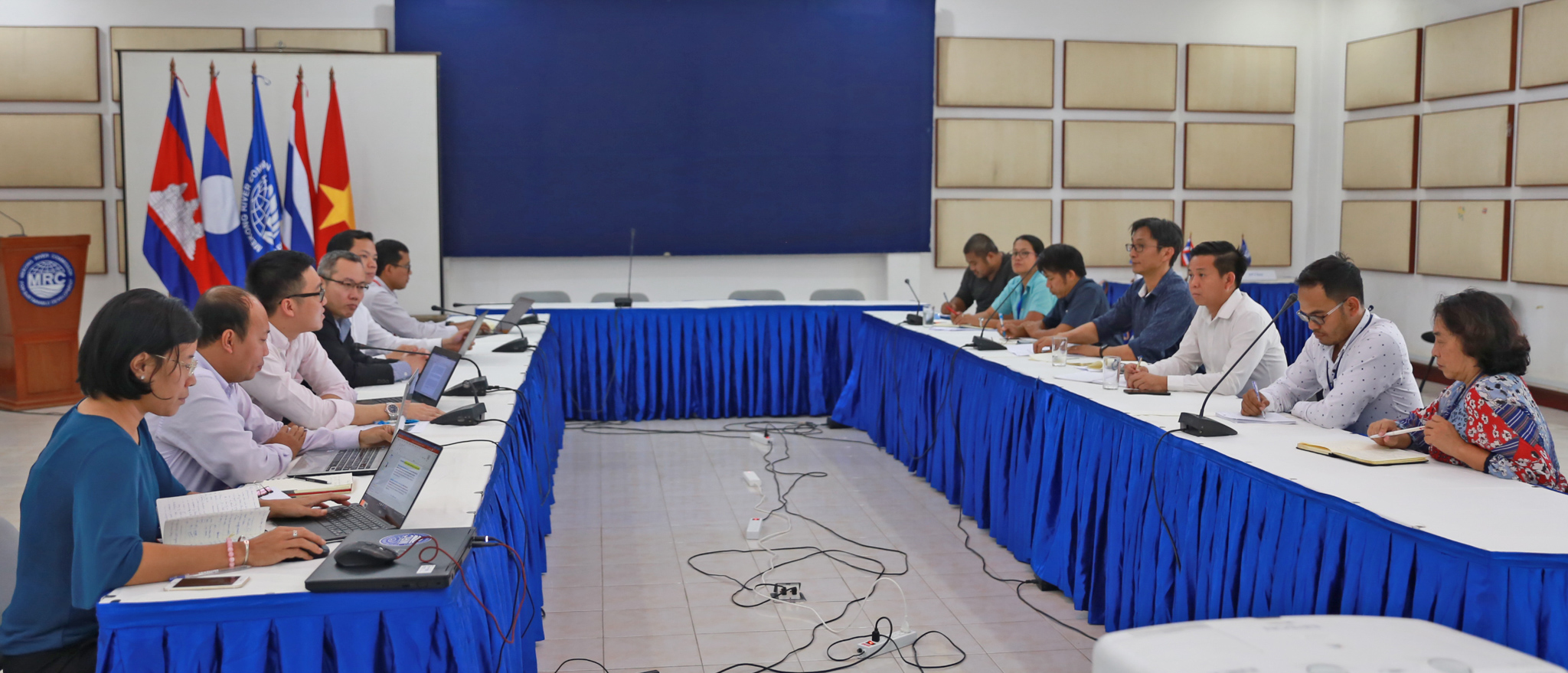
The MRC Secretariat holds dialogues with representatives of civil society organizations to foster mutual understanding and actions in support of sustainable development in the Mekong.
On communication, media and outreach The MRC has also significantly intensified its presence online through its main website and Facebook page, and hosted several social media campaigns, such as in March 2020 in celebration of MRC 25th Anniversary. Some of the notable campaigns were as follows: • The MRC launches regional photo contest to promote Mekong water use cooperation, July 2017 • The MRC awards photo contest winners and launches photo exhibition to promote Mekong water use cooperation, December 2017 • Photo exhibition of the Mekong River increases awareness of water cooperation, January 2018 • Five riparians win the MRC writing competition: What does the Mekong mean to you? March 2018 • The MRC marks Tree Day with a planting ceremony to promote environmental sustainability, June 2018 • Mekong student open day at MRC, July 2018 • The MRC awards writing competition winners to celebrate Mekong’s shared value, promote inclusive planning and management, July 2018 • MRC awards green campaign winners to celebrate Mekong Day and raise awareness of plastic pollution, April 2019 • Campaign launched to celebrate the 25th Anniversary of the MRC and inspire river protection, March 2020.
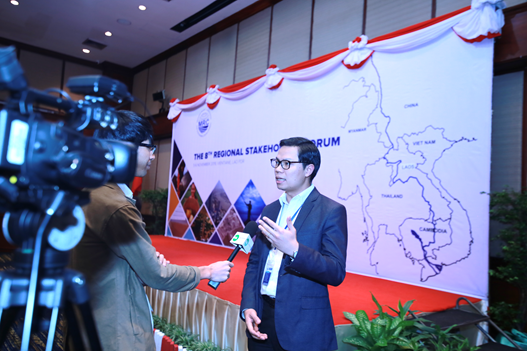
MRC Secretariat Chief of Strategy and Partnership Officer, Dr Anoulak Kittikhoun, also the MRC Secretariat Spokesperson, answers questions from the media during the 8th Regional Stakeholder Forum (November 2019).
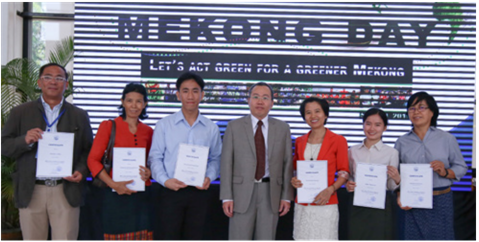
Dr An Pich Hatda, CEO of the MRC Secretariat, poses for a group photo with winners of the MRC Green Campaign to celebrate the Mekong Day anniversary and raise awareness of the danger of plastic waste in the Mekong River Basin (5 April 2019).
Evidence of change
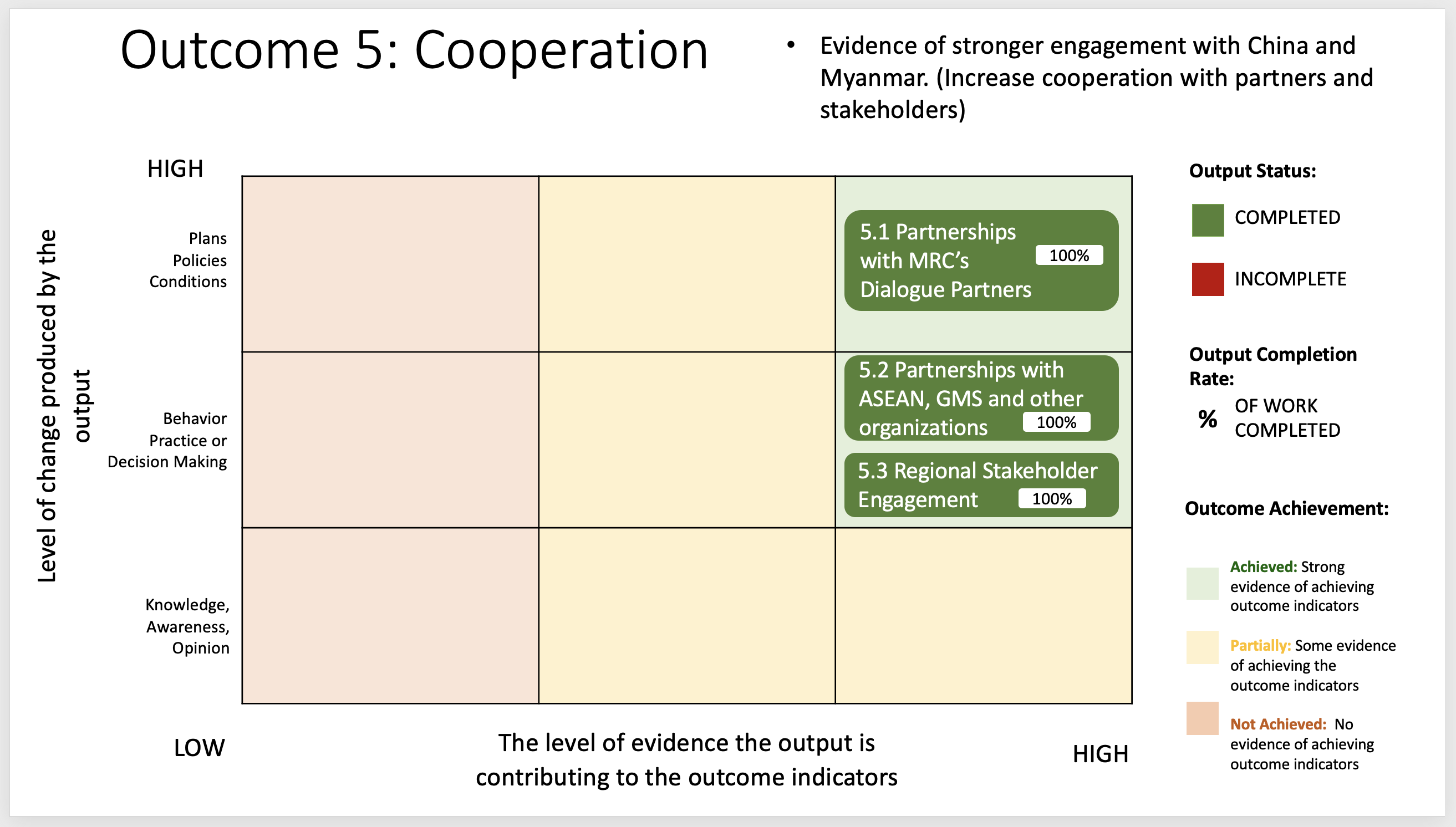
Figure 34. Outcome Evaluation Matrix
Note: The Matrix assesses outcome achievement based on output completion and the type of change that occurred – Outcome 5
Increased knowledge and understanding Evidence of positive changes and benefits as a result of the MRC’s continuing dialogue and cooperation with its regional and international partners include: increased awareness and common understanding among partners of the critical basin issues and challenges, which enabled better support; increased capacity of the MRC Secretariat’s staff and MCs as a result of technical information exchanges, exchange visits, and workshops, including both immediate use and application of practice, such as stakeholder engagement and more medium-term implementation such as basin planning, hydropower management and operation, and flood and drought management; improvements in MRC processes as a result of lessons and best practices learned from other cooperation frameworks and other basin organizations; and infusion of new or additional funding from Development Partners and other partner organizations in support of critical activities.
Strengthened relationship and cooperation with Upper Mekong countries The continuing dialogue, information exchanges, and joint initiatives have resulted in a strengthened relationship and cooperation with China and Myanmar, benefiting the MRC as an organization and the entire Basin.
Regional and global recognition The MRC’s efforts in expanding and strengthening its relationship with regional and international partners are contributing to its positive reputation regionally and globally. The MRC has clearly demonstrated its central and leadership role in the region, as evidenced by the reaffirmation of its mandate through the Siem Reap Declaration, and its increasingly strategic and productive partnership with its Dialogue Partners. MRC’s new Cooperation Framework with ASEAN at the organization level is a recognition of the MRC’s critical role in bringing sustainable development to the Mekong sub-region of ASEAN. Through the technical and financial support of its growing list of regional and international partners, the MRC has produced an impressive body of knowledge, experience, and best practices in IWRM-based river basin planning and development that are highly relevant and beneficial to other river basin organizations and the international community. This contribution to the world literature is further reinforcing the positive image of the MRC globally.
Meaningful stakeholder communication and participation Evidence of a broader range of actively engaged stakeholders has been increasing, as reflected in Figure 35. This is the direct result of sustained and improved stakeholder efforts by the MRC and stronger commitment for an open, transparent, and inclusive process through several mechanisms, which include the RSFs, national stakeholder consultations, regular updates of the MRC website, and use of social media such as Facebook, Twitter, and LinkedIn, Facebook campaigns and livestreaming of important events, and outreach events. More importantly, the comments, opinions, and suggestions of the broader stakeholders have been heard and incorporated into MRC products, including the BDS, PNPCA Joint Statements, Technical Review Reports (TRR), the PDG, and the SHDS, among many others. Finally, the MRC’s efforts to reach out to stakeholders have resulted in its more balanced and neutral media coverage.
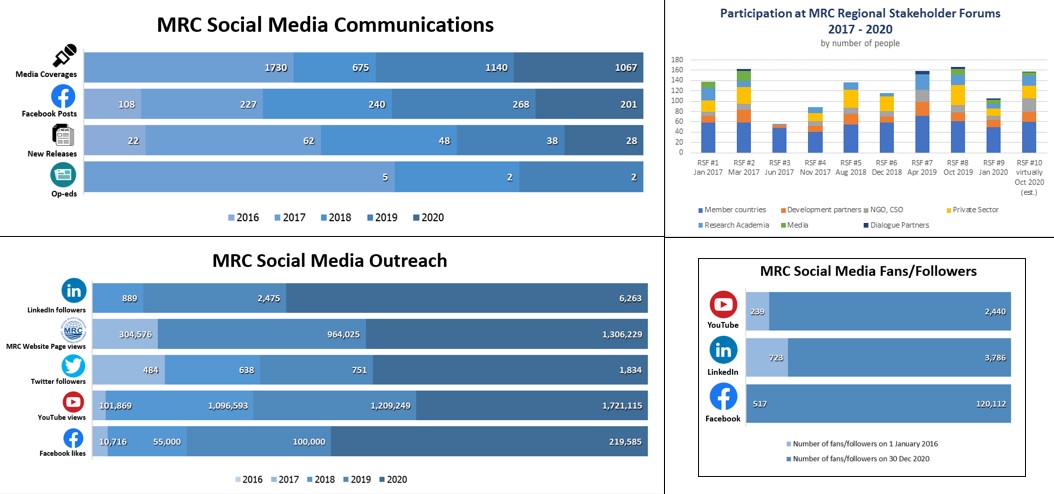
Figure 35. Key statistics indicating the MRC’s efforts and results in improving stakeholders’ communications and outreach